Today’s USA Today asked a bunch of food safety types what the government could do to improve the school lunch program.
 My full answer included,
My full answer included,
“Does it have to be government? They’re not very good at this stuff.”
What got published this a.m., along with a photo by Dave Adams of Kansas State, was,
"Government should set minimal standards and demand continuous improvement from all of its suppliers. More importantly, every cafeteria needs to make microbial food safety — from hand washing to food handling — part of the daily culture."
Douglas Powell, professor of food safety at Kansas State University and the publisher of barfblog.com.
The story explains that in 1982, hamburgers from McDonald’s fast-food chain sickened at least 47 people in Oregon and Michigan. No one died, but the pathogen that caused the severe cramps, abdominal pain and bloody diarrhea turned out to be a little-known, especially dangerous form of the common stomach bacteria E. coli. The new subtype, E. coli O157:H7, produced a toxin that destroyed red blood cells and, in later cases elsewhere, caused kidney failure or death.
Confounded by the discovery, McDonald’s hired one of the nation’s best-known food safety scientists, Michael Doyle, and told him, he recalls, "to bulletproof their system so E. coli never happened to them again."
 McDonald’s reconsidered its old assumptions about food — from how often beef-processing plants should test ground beef to how well a hamburger must be cooked to kill off pathogens such as E. coli and salmonella.
McDonald’s reconsidered its old assumptions about food — from how often beef-processing plants should test ground beef to how well a hamburger must be cooked to kill off pathogens such as E. coli and salmonella.
The results helped change the industry. For years, the federal food code said burgers had to be cooked only until their internal temperature reached 140 degrees; McDonald’s tests showed the safe standard was 155 degrees and that the meat must register that temperature for at least 15 seconds.
Microbial data also altered the demands McDonald’s imposed on its suppliers.
After a couple of years, the company saw that "about 5% of the suppliers could not get down to what we considered a reasonable level for salmonella and E. coli," says Doyle, now director of the University of Georgia’s Center for Food Safety. "McDonald’s worked hard with them, but they couldn’t get there, so McDonald’s let them go."
The lesson, many analysts say, is that organizations with great buying power — such as fast-food chains or the school lunch program — can set higher standards, and industry ultimately will meet those standards because that’s where the money is. The school lunch program purchases huge volumes of commodities such as beef, poultry and other staples –– $830 million worth in 2008.
 Yet according to him, he was suffering from food poisoning he had developed while on his holiday – experiencing stomach cramps, diarrhea and vomiting.
Yet according to him, he was suffering from food poisoning he had developed while on his holiday – experiencing stomach cramps, diarrhea and vomiting.



 My full answer included,
My full answer included, McDonald’s reconsidered its old assumptions about food — from how often beef-processing plants should test ground beef to how well a hamburger must be cooked to kill off pathogens such as E. coli and salmonella.
McDonald’s reconsidered its old assumptions about food — from how often beef-processing plants should test ground beef to how well a hamburger must be cooked to kill off pathogens such as E. coli and salmonella. I told
I told  thermometer in his front pocket, which I asked to borrow for the interview. One of the PR types said something like, you can’t go on TV and talk about using thermometers, we have enough trouble getting Australians to store food in the fridge, which is largely used for beer.
thermometer in his front pocket, which I asked to borrow for the interview. One of the PR types said something like, you can’t go on TV and talk about using thermometers, we have enough trouble getting Australians to store food in the fridge, which is largely used for beer. I probably contracted a slight case of food poisoning while honeymooning in the Dominican Republic. So did my wife, and I spent my birthday, literally, in the bathroom and having to use baby wipes on sensitive and inflamed, uh, skin.
I probably contracted a slight case of food poisoning while honeymooning in the Dominican Republic. So did my wife, and I spent my birthday, literally, in the bathroom and having to use baby wipes on sensitive and inflamed, uh, skin. • if you want to be extremely careful, even though the hotel tap water is purified, always use bottled water if it will end up in your mouth such as washing your toothbrush, mouth guard (yes, I wear one myself due to grinding), or even rinsing the toothpaste from your mouth – if you use the tap water for any of these, and it happens to be tainted, you will get sick.
• if you want to be extremely careful, even though the hotel tap water is purified, always use bottled water if it will end up in your mouth such as washing your toothbrush, mouth guard (yes, I wear one myself due to grinding), or even rinsing the toothpaste from your mouth – if you use the tap water for any of these, and it happens to be tainted, you will get sick.